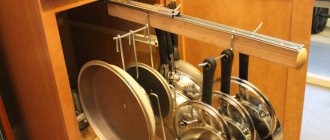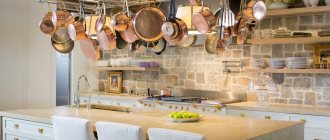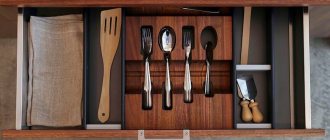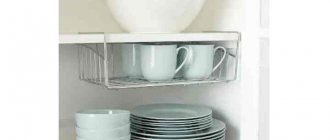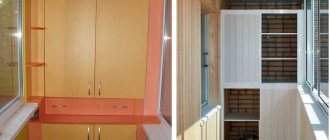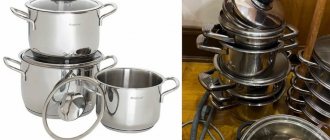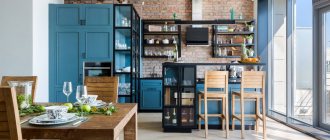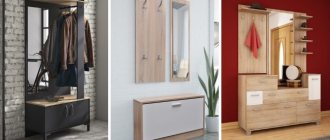Compact placement of large kitchen utensils will save space, so necessary in small rooms. You can properly organize the storage of pots, pans and lids in the kitchen with the help of modern organizers. But even without buying them, you can arrange the dishes conveniently. So that it will not interfere and will not take up much space in the closets. A well-organized space will make it easy to find the utensils you need. And after use, quickly put it back in place.
Railing
Connoisseurs of an open storage system will find roof rails that will allow you to use the kitchen space to the maximum.
Place the pans on a non-functional part of the wall, hanging them from the holes in the handles. The railing can also be secured under the shelf to complement the design and make the composition more complete. If you turn the pans upside down, less dust will accumulate inside.
Hooks in the closet
This is one of the simplest and most budget-friendly ways to arrange pans conveniently: hanging hooks are inexpensive and easy to install. You can screw them to the bottom of the shelf or hang them on a rod. Ideal for those who want to hide kitchen utensils behind closed fronts.
Check out our collection of ideas for organizing your kitchen cabinets.
Hanging frame
The structure is also called roof railing. It adds originality to the interior, fits perfectly into lofts, chalets and country houses, and is indispensable in a private home to save space. Can be placed above a work surface, an island or even a dining area - if the ceilings are high, the frame will not cause any trouble.
Instead of a metal store-bought product, you can use a wooden ladder with thin rungs.
Under the work surface
The classic way to store pans, which is provided by the kitchen furniture manufacturer: a retractable system under the work surface or stove panel. The advantages include the convenience of placing the lids, an easy way to stack and use them. Usually, storing pan lids causes a lot of inconvenience for the housewife.
Photo: kitchendecorpad.com
Wall
This method allows you to save even more space and does not require the cost of roof rails. It is enough to secure the required number of reliable hooks to the wall - for example, in a niche.
To protect the surface from scratches and chips, the area can be painted with durable chalkboard paint or wooden slats can be nailed down.
On a forged hook
Calculate the exact cost of repairs using an online calculator
and receive a free detailed estimate for repairs
Calculate
The abundance of wood in kitchen decoration is often accompanied by copper utensils and accessories. In this case, of course, there is also no need to hide beautiful frying pans, but the copper ones will decorate the interior more than serve their intended purpose. A forged shaped hook can be attached to a ceiling beam and you can use frying pans to create an interesting composition. Other copper elements are also very desirable in such a kitchen: faucets, fittings, finishing of wooden furniture.
Photo: forbes.com
Perforated board
If there is a catastrophic lack of space in the kitchen, but you want to make the storage area as impressive as possible, hang a perforated board with removable hooks.
Kitchen appliances can be arranged in a strictly defined order and circled, as shown in the first photo, or placed randomly.
Space saving
Modern kitchen designs often include storage for pans and pots. Additional technical organizers help to correctly place a large amount of dishes. This type of kitchen arrangement does not require extra storage space. But kitchens that have been equipped with furniture for a long time require some attributes to accommodate dishes.
This problem applies to those rooms that have a small area. Small kitchens don't always have room for extra cabinets or chests of drawers for storage, so there are several ways to place pans in such a room.
"Matryoshka"
If none of the methods works for you, simply place the pans inside each other, using special tabs to protect the non-stick coating. With them, you will protect not only the bottom of the container, but also the walls: in this position, the dishes can be stored both in the cabinet and in the oven. If desired, you can make the inserts yourself.
These ideas will help you think differently about storing pans in the kitchen, making your workspace more comfortable and saving space.
Convenient storage of pots, pans and lids
To ensure that finding the right pan does not take a lot of time, it is advisable to disassemble all the dishes. Gather together all the lids, all the pans and pots. Depending on the size, choose a convenient place where it will be easy to place the largest item.
If the household has large containers that are not used daily (cauldron, pressure cooker, etc.), then you can allocate a special place for them where they will not interfere. An option for storing such containers would be to use them as a container for smaller items.
For small cabinets that do not allow you to freely arrange all the necessary dishes, use non-traditional storage areas.
If the dishes are open to view, then it is better to buy them in a decorative design. Then it will serve as an element of kitchen design.
When you sort and organize large utensils, you will free up a lot of space in your kitchen.
Storage on rails and hooks
Railing is a convenient storage system for kitchen utensils. Ready-made components can be easily purchased at hardware and dishware stores. The kit necessarily includes a rod holder. Attach hooks and hangers, shelves, stands for convenient placement of lids, etc. to them yourself.
Rails are available in chrome and painted versions. These are universal sets that are suitable for kitchens decorated in any style. They are convenient to install above the island in a large kitchen or above the work area in a small one. Hanging pans do not disturb the housewife and serve as interior decor.
Matryoshka principle
The most common and convenient storage method. The pots are sorted by size and arranged from smaller ones to larger ones. When making a set of dishes, the containers are immediately selected so that they can be stacked one inside the other.
Pans (they are specially made with removable handles) and baking dishes are stored using the same principle. When storing this way, you don't have to place the lids separately, but sometimes you still have to do it.
Pan and lid
The method is suitable for a spacious kitchen, where you can put a separate cabinet for large utensils. The convenience of the method lies in the joint placement of the container and its lid. A number of furniture sets have special cabinets with compartments for dishes and a lid for them.
You can install dividers in your kitchen unit yourself and divide the cabinet space into similar zones.
Pull-out sections
Systems with pull-out and roll-out sections allow you to store large dishes in deep cabinets. When there are no sections, it is difficult to place and remove the necessary items. And their neat, compact installation is almost impossible. But in a small cabinet, pull-out sections made of metal profiles allow you to arrange pots and pans and conveniently place lids on them.
When looking for the required container, the housewife just needs to roll out the lightweight structure from the depths of the closet and take what she needs without interference. When closed, the pull-out sections are compact and hidden under the work area tabletop.
Table stands
The organizer stand consists of a lattice base, the holes of which are used to install lids in them, and the pots can be stored separately, assembled like a nesting doll and hidden in a cabinet drawer. This is also convenient for drying plates.
Tabletop stands are designed by designers so as not to take up much space on the table in the work area or near the sink. Some models have loops for wall mounting.
